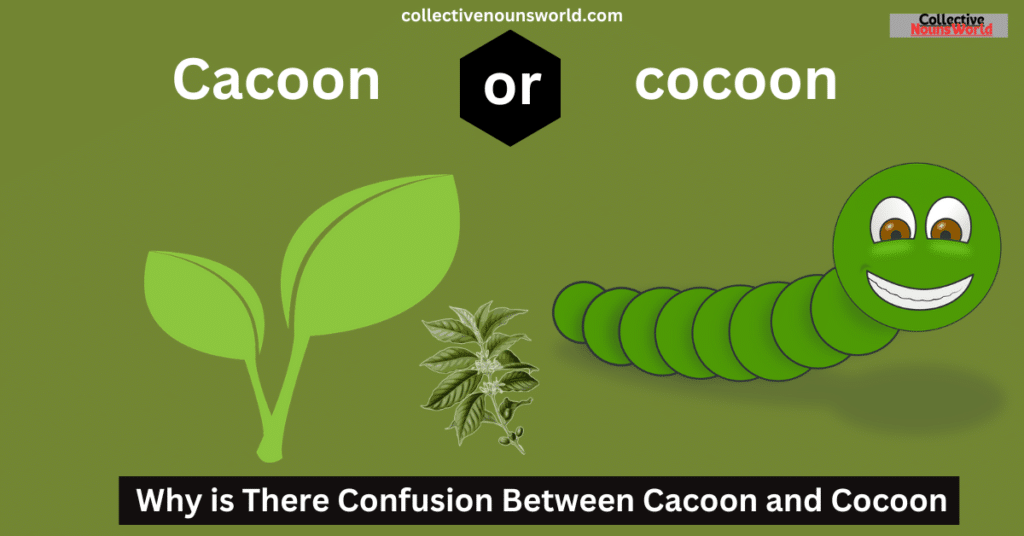When deciding between cacoon or cocoon, it’s important to know the difference. The correct spelling is cocoon, which refers to the protective casing that insects like caterpillars and moths form during their metamorphosis. This cocoon plays a crucial role in their development, offering safety as they undergo changes.
On the other hand, cacoon is an uncommon spelling, and it’s used in botany to describe a medicinal plant called Fevillea cordifolia, which has been traditionally used in some cultures. So, while cocoon is widely recognized in entomology and silk production, cacoon or cocoon is a simple mix-up of words that can easily be avoided once you understand the distinction.
Why is There Confusion Between Cacoon and Cocoon?
There is often confusion between cacoon and cocoon because they look very similar. Both words contain the same letters but in different orders. This makes it easy to mix them up, especially when people are typing quickly or aren’t familiar with the correct spelling. Another reason for the confusion is that the words sound the same. So, when we hear someone mention a “cacoon,” it may not sound wrong, but in fact, it is.
The confusion also comes from the fact that cocoon has different meanings in different fields. In entomology, it refers to the protective casing that insects, like caterpillars, spin around themselves during metamorphosis. However, cacoon is not typically used in entomology. It is a rare term used in botany, referring to a specific plant known as Fevillea cordifolia.
What is a “Cacoon”?
Definition of Cacoon
The word cacoon is not commonly used in everyday language. In fact, it is a botanical term referring to the Cacoon plant, scientifically known as Fevillea cordifolia. This plant is found in tropical regions and is known for its medicinal properties. While it may seem similar to cocoon, this term is very specific and should not be confused with the insect-related meaning of cocoon.
Common Uses of “Cacoon”
You might come across the term cacoon in certain specialized texts, usually when referring to the Cacoon plant. This plant, which grows in tropical areas, has been used in traditional medicine. However, using cacoon to refer to a cocoon made by an insect, or any other kind of protective casing, is a mistake. It’s important to remember that cacoon should be used in the context of botany, not entomology.
What is a “Cocoon”?

Definition of Cocoon
The word cocoon is much more common and widely recognized. In entomology, a cocoon is a protective covering created by insects like moths or butterflies during their metamorphosis. The insect forms a cocoon to shield itself as it transforms from a larva into an adult insect. This casing is usually made of silk, which the insect produces.
A cocoon also has metaphorical meanings. It can refer to a state of isolation or comfort, much like how a caterpillar is protected inside its cocoon during transformation. For example, people sometimes speak of needing to cocoon themselves when they want to retreat from the outside world and focus on personal growth.
Common Uses of “Cocoon”
In everyday language, cocoon is used in a variety of ways. In its entomology context, it refers to the protective casing that insects create. But beyond this, cocoon can also be used metaphorically. For example, someone might say, “I need a break to cocoon and recharge.” In this case, the word is not about the insect’s protective casing, but rather a period of rest or personal growth.
Read more about Excel or Accel: Which is Correct?
Cacoon vs. Cocoon: Key Differences
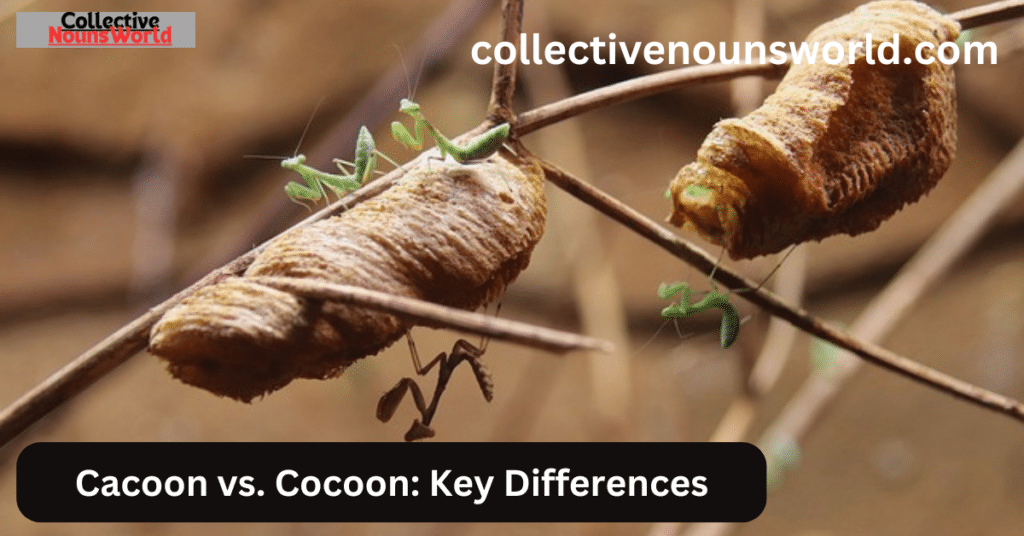
Spelling
The most obvious difference between cacoon and cocoon is the spelling. Cocoon is the correct word, while cacoon is a misspelling. Many people mistakenly add an extra “a” in the word, likely because it seems more natural to them. However, cocoon with two “o”s is the only correct form when referring to the insect casing.
Meaning
While the meanings of the two words are quite different, the most significant distinction is the context in which they are used. Cacoon refers to a plant used in medicine, while cocoon refers to an insect’s protective casing. If you’re talking about a moth or butterfly’s transformation, cocoon is always the correct choice.
Usage
In terms of usage, cocoon is much more common. It appears in conversations about insect metamorphosis, silk production, and even cocoon metaphors. In contrast, cacoon is used in very specific scientific contexts relating to the Cacoon plant and its medicinal properties. So, if you’re not talking about the plant, cocoon is almost always the right word to use.
Examples of “Cacoon” and “Cocoon” in Context
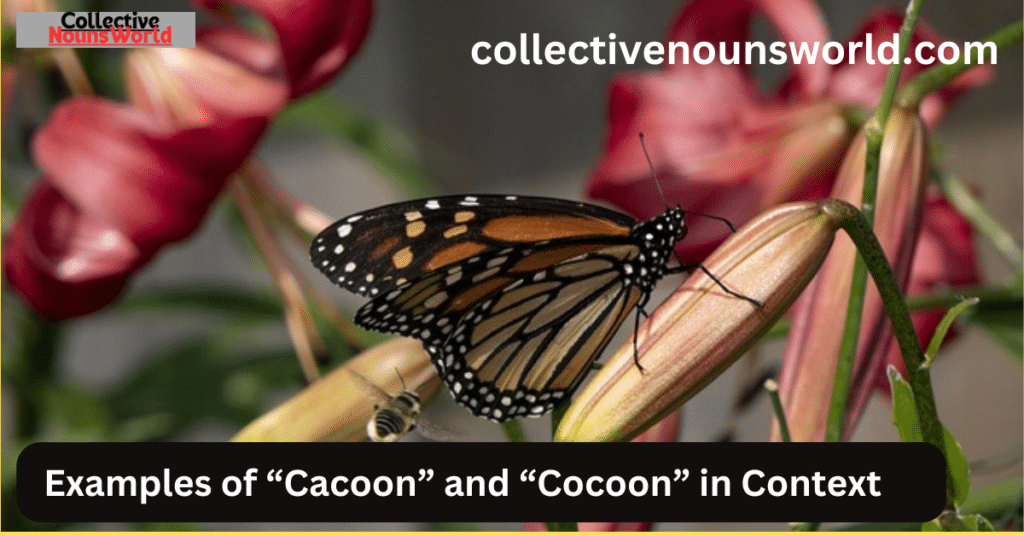
“Cacoon” in Sentences
You might encounter cacoon in specialized botanical contexts, but it’s important to avoid using it in place of cocoon in more general situations. For example, the sentence, “The cacoon protects the caterpillar,” is incorrect. The correct word here is cocoon, not cacoon. Another incorrect sentence would be: “The cacoon is made of silk.” Again, cocoon is the proper term.
“Cocoon” in Sentences
The term cocoon is used correctly in a sentence like: “The caterpillar forms a cocoon to protect itself.” In this example, the cocoon refers to the silk casing spun by the caterpillar. Another correct usage would be: “She decided to cocoon herself in her room and spend the weekend reading.” Here, the term is used metaphorically, referring to a safe and isolated environment.
Origins of “Cacoon” and “Cocoon”
The Origin of “Cacoon”
The word cacoon likely comes from the botanical world, where it was used to refer to the Cacoon plant (Fevillea cordifolia). This plant has a rich history in certain traditional medicines. However, its use in language is very limited, and it’s not a widely recognized term outside of specific scientific discussions.
The Origin of “Cocoon”
The correct term cocoon has a rich etymological history. It comes from the French word cocon, which means “egg” or “pupa.” This word itself has roots in Latin, where coconus referred to a protective covering. Over time, the term evolved in English to describe the silky protective casing created by insects like moths and butterflies.
Why “Cocoon” is the Correct Spelling
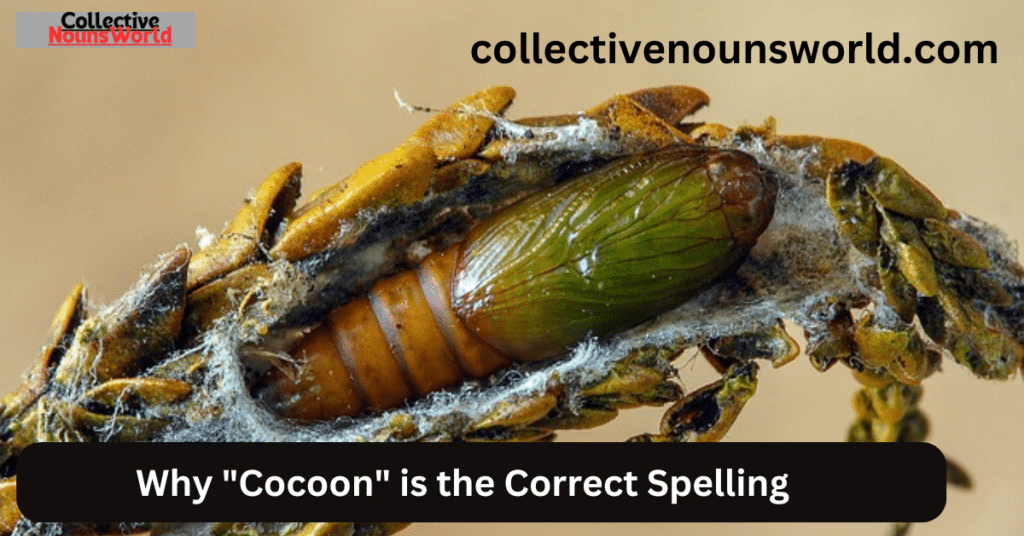
Linguistic Reasons
The spelling cocoon is the standard because it follows the usual linguistic patterns in English. The double “o” makes the word easier to pronounce and aligns with its French and Latin origins. The spelling cacoon is incorrect and should be avoided unless referring specifically to the Cacoon plant.
Historical and Cultural Influences
Over time, the word cocoon has been widely accepted in both scientific and cultural contexts. It is used to describe the protective casing of insects, and it is also common in literature and art to symbolize transformation, isolation, or growth. This cultural usage of cocoon has made it the correct term in most situations.
Common Mistakes with Cocoon Spelling
Misspellings of “Cocoon”
Many people misspell cocoon as cacoon, and while it’s easy to make this mistake, it’s important to avoid it. Common misspellings also include cocoonn, coconne, and cocoonne. These errors are usually caused by a mix-up of letters or by trying to make the word sound more familiar.
How to Avoid the Cacoon Mistake
A simple way to avoid misspelling cocoon as cacoon is to remember that cocoon has two “o”s, just like the wings of a butterfly. Another trick is to think of cocoon as a safe, two-part protective casing: two “o”s to remind you of the transformation process that happens inside.
Read more about Reinforce vs Reenforce: Simple Guide [2024]
Tips for Remembering the Spelling of “Cocoon”
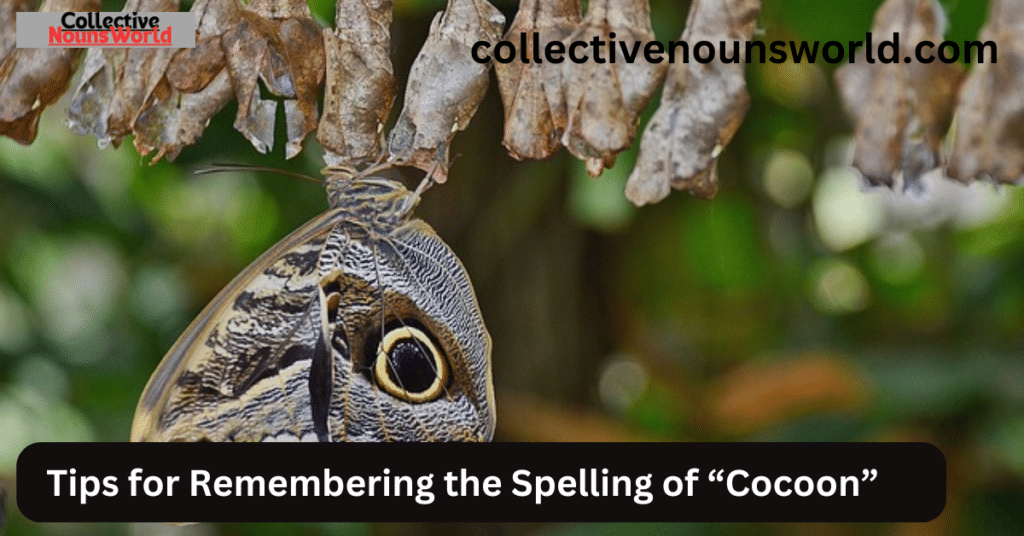
Mnemonics and Memory Tricks
To help you remember the correct spelling, think of a cocoon as a “home” for the caterpillar, and just as a home is often made up of different parts, cocoon has two “o”s to represent those parts. This simple trick can
help ensure you always use the correct spelling.
“Cocoon” in Everyday Language: Beyond Spelling
Cocoon as a Verb
In addition to being a noun, cocoon can also be used as a verb. To cocoon means to wrap or envelop something in a protective way. For example, you might say, “She cocooned herself in a warm blanket on a cold night.” This verb use still retains the idea of protection and isolation.
Psychological and Social Implications of Cocooning
The term cocooning has taken on metaphorical meanings in psychology and social behavior. People sometimes talk about cocooning when they retreat from the busy world to focus on themselves. It can represent a time for personal growth or healing, much like how a caterpillar transforms within its protective cocoon.
The Lifecycle of a Cocoon: From Larva to Butterfly
Phases of Metamorphosis
Insects like moths and butterflies undergo metamorphosis, changing from a larva (caterpillar) to an adult through a series of stages. The first stage is when the insect is an egg, followed by the larva stage (caterpillar), and then the pupa stage, where it forms a cocoon. Inside the cocoon, the insect undergoes transformation, emerging as an adult insect.
Cacoon vs. Cocoon: Understanding

The Key Takeaways
The main difference between cacoon and cocoon is that cocoon is the correct word. Cacoon refers to a medicinal plant, while cocoon is the protective casing made by insects.
Why Understanding the Difference Matters
Understanding the difference between these two terms is important because using the wrong word can confuse your audience. Always remember to use cocoon when referring to an insect’s protective casing or the metaphorical idea of protection and transformation.
Related Terms and Synonyms for Cocoon
Synonyms for Cocoon
Synonyms for cocoon include words like pupa, chrysalis, and larva. These terms are used in entomology to describe different stages of an insect’s life cycle.
Synonyms for Cacoon (and Why They Aren’t Correct)
Cacoon is very specific and not commonly used in other contexts. Misusing it as a synonym for cocoon leads to confusion, so it’s best to avoid using it unless you’re referring to the Cacoon plant.
Read more about Emersion vs. Immersion: Understanding the Differences
Exploring the Etymology of “Cocoon”
How the Word Evolved
The word cocoon evolved from the French cocon, which came from Latin coconus. This etymology reflects the protective role of the casing. As the word entered the English language, it came to symbolize protection and transformation, much like the life stages of an insect inside a cocoon.
Conclusion:
The correct term is cocoon, not cacoon. While cocoon refers to the protective casing created by insects like moths and butterflies, cacoon is a rarely used botanical term referring to a specific medicinal plant. It’s important to understand these differences to avoid confusion. Always use cocoon when discussing insect metamorphosis, silk production, or even the metaphorical meaning of transformation and protection. Now that you know the distinction between cacoon or cocoon, you can confidently use the right word in your writing.

Luna Jasper is an experienced blogger with a passion for language and grammar. At **Collective Nouns World**, she shares her expertise in exploring the fascinating world of collective nouns, making learning both engaging and fun. With years of writing and research under her belt, Luna’s insightful articles help readers understand and appreciate the English language.

